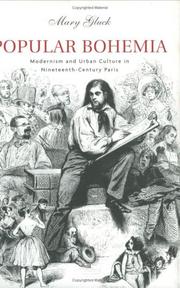| Listing 1 - 4 of 4 |
Sort by
|
Book
ISBN: 0674348656 Year: 1985 Publisher: Cambridge (Mass.): Harvard university press
Abstract | Keywords | Export | Availability | Bookmark
 Loading...
Loading...Choose an application
- Reference Manager
- EndNote
- RefWorks (Direct export to RefWorks)

ISBN: 9780674027312 0674015304 0674027310 9780674015302 0674037677 9780674037670 Year: 2005 Publisher: Cambridge Harvard university press
Abstract | Keywords | Export | Availability | Bookmark
 Loading...
Loading...Choose an application
- Reference Manager
- EndNote
- RefWorks (Direct export to RefWorks)
This book revises dominant historical narratives about modernism from the perspective of a theoretically informed cultural history that spans the period between 1830 and 1914. In doing so, it reconnects the intellectual history of avant-garde art with the cultural history of bohemia and the social history of the urban experience to reveal the circumstances in which a truly modernist culture emerged.
Arts, French --- Modernism (Aesthetics) --- Arts and society --- Art and popular culture --- Bohemianism --- History --- Modernisme (Esthétique) --- Arts et culture populaire --- Vie de bohème --- Modernisme (Esthétique) --- Vie de bohème --- Popular culture and art --- Arts and sociology --- Society and the arts --- Sociology and the arts --- French arts --- Arts --- Popular culture --- Manners and customs --- Hippies --- Aesthetics --- Social aspects --- History of civilization --- anno 1800-1899 --- Paris --- Arts français --- Arts et société --- Histoire --- Arts [French ] --- France --- Paris (France) --- 19th century
Book
ISBN: 9780299307738 0299307735 9780299307707 0299307700 Year: 2016 Publisher: Madison, Wisconsin
Abstract | Keywords | Export | Availability | Bookmark
 Loading...
Loading...Choose an application
- Reference Manager
- EndNote
- RefWorks (Direct export to RefWorks)
Nearly a quarter of the population of Budapest at the fin de siècle was Jewish. This demographic fact appears startling primarily because of its virtual absence from canonical histories of the city.Famed for its cosmopolitan culture and vibrant nightlife, Budapest owed much to its Jewish population. Indeed, it was Jews who helped shape the city's complex urban modernity between 1867 and 1914. Yet these contributions were often unacknowledged, leading to a metaphoric, if not literal, invisible status for many of Budapest's Jews.In the years since, particularly between the wars, anti-Semites within and outside Budapest sought to further erase Jewish influences in the city. Appellations such as the "sinful city" and "Judapest" left a toxic inheritance that often inhibited serious conversation or scholarly research on the subject.Into this breach strides Mary Gluck, whose goal is no less than to retrieve the lost contours of Jewish Budapest. She delves into the popular culture of the city's coffee houses, music halls, and humor magazines to uncover the enormous influence of assimilated Jews in creating modernist Budapest. She explores the paradox of this culture, which was Jewish-identified yet lacked a recognizable Jewish face. Because much of the Jewish population embraced and promoted a secular, metropolitan culture, their influence as Jews was both profound and invisible.
Popular culture --- Jews --- Hebrews --- Israelites --- Jewish people --- Jewry --- Judaic people --- Judaists --- Ethnology --- Religious adherents --- Semites --- Judaism --- Culture, Popular --- Mass culture --- Pop culture --- Popular arts --- Communication --- Intellectual life --- Mass society --- Recreation --- Culture --- History. --- Cultural assimilation --- Budapest (Hungary) --- Budimpešta (Hungary) --- Budapesht (Hungary) --- Voudapestē (Hungary) --- Buda (Hungary) --- Pest (Hungary) --- Ethnic relations. --- History --- Óbuda (Hungary)
Book

ISBN: 9781782384786 Year: 2001 Publisher: New York Oxford
Abstract | Keywords | Export | Availability | Bookmark
 Loading...
Loading...Choose an application
- Reference Manager
- EndNote
- RefWorks (Direct export to RefWorks)
| Listing 1 - 4 of 4 |
Sort by
|

 Search
Search Feedback
Feedback About UniCat
About UniCat  Help
Help News
News